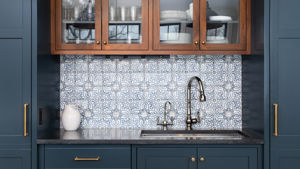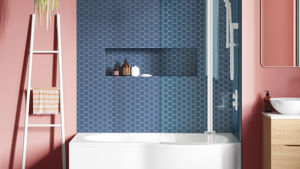When you and your partner are expecting a child, it can be exciting and terrifying in equal measure. It doesn’t matter whether it’s your first or not, you never feel fully prepared. Even before the baby is born there’s so much to do; you have to buy clothes, nappies, a car seat, a pram, a cot; the list is seemingly endless. One of the most important things to do, however, is baby-proofing your home. The kitchen and living room are often done, but it’s amazing how many people forget to baby proof their bathroom - one of the most dangerous rooms in the house. But where do you even begin? That’s where this guide comes in. We’re about to share with you our top tips for baby proofing a bathroom.
Keep An Eye Out
This first tip isn’t so much something that you do to your bathroom; it’s more of a behavioural thing. Babies and very young children are inquisitive and have little to no sense of danger. When they’re in the bathroom - or anywhere for that matter - you don't want to take your eyes of them for long. At no time is this more important than when they’re in the bath. You may think that they’ll be fine for 10 seconds whilst you go and grab your phone from the bedroom to take a cute picture of them, but balance is not their strong point and if they fall in the water, it only takes a split second for them to drown. It doesn’t matter if there’s not much water in the bath either as it’s possible to drown in less than 2 inches of water. Even if you have a baby bath seat, it’s still possible for them to topple over and end up in the water. It’s not worth the risk!
Getting the Right Temperature

Babies and young children have very sensitive skin, especially when it comes to temperature. You or I may be able to get in a bath or shower that, for us, is uncomfortably hot or cold, but our body is able to react and adapt to the temperature. Of course, if the water really is too hot or too cold, it can severely injure us, causing hyperthermia or even burns if it’s too hot, or hypothermia if it’s too cold.
Having the wrong temperature in the bath can be much more dangerous to a baby, so it’s imperative that you get the temperature right for them. It is recommended to bathe babies and small children in water that is between 36°C and 38°C - around the temperature of the human body. The ‘elbow test’ is the most common way of testing the water temperature, but what may feel just right to you may be too hot for your child. The best way to ensure that you have the right temperature is to install a thermostatic bath tap or thermostatic shower valve. The thermostatic technology in these taps and valves ensures that the water comes out at the precise temperature that you set, so you can always be sure that you’ve run the perfect bath. Many thermostatic valves also have safety features in them that shut off the water should the hot or cold water supply to the valve fail as well as a maximum temperature setting.
Let's take a look at a few of our favourites with that oh-so-important anti-scald technology.
Soft Close for Soft Hands
As soon as babies start to crawl they start to climb. And what do they use to climb? Their hands? Yes, but also anything that they can grab onto. You’ll discover that almost anything in your bathroom can be used by your child to help them climb. This includes: the side of the bath, the toilet and handles on vanity units, among other things. And once a baby discovers that by pulling something - like the handle on a vanity unit door - it opens, they’ll want to do it again and again. Unfortunately, babies don’t understand the laws of physics just yet so they’re not prepared for what happens when they let go. Having a hefty wooden toilet seat or a vanity unit door trap your hand is not pleasant, to put it mildly.
So, how can you stop this from happening? We recommend making sure that everything that opens in your bathroom has soft close hinges. If you already have a vanity unit without soft close doors, you may be able to just buy soft close hinges for it so you don’t have to fork out for a brand new vanity unit. If, however, you can’t, or you’ve been looking for an excuse to buy a new vanity unit anyway, we have a huge selection of vanity units in all shapes and sizes. Most come with soft close doors or drawers, but it’s best to read the product description just to be certain.
Removing the danger that your toilet seat poses is even simpler. We have a huge range of soft close toilet seats - both wooden and plastic - that can be fitted on most sizes of toilets. Just be sure check the dimensions of your current seat and your chosen new one to make sure that they will fit.
Let's take a peek at our top soft close vanity units and toilet seats to keep those fingers out of harm's way.
Keep It Clean
As we’ve already mentioned, babies and small children are very inquisitive - it’s how they learn, but it’s also how they can get hurt. One of the ways that they learn is touch, and another way is taste. Unfortunately, they haven’t leant about hygiene yet, and quite often you’ll find them putting their hands somewhere that isn’t entirely clean and then putting that hand straight in their mouth. As much as you can try, you’re not going to be able to stop them every time. So it’s best that you make sure that everything they touch is as clean as possible.
If we think about your house like an ecosystem, then the bathroom is most like a rainforest. And where in the world do we find the most life? That’s right, the rainforest, so it’s not a surprise that the bathroom is where you’re most likely to find bacteria. There are ways to prevent this though.
One of the most important things is to ensure that your bathroom has proper ventilation. All that condensation and water vapour after you’ve had a hot shower may make it look like you’re appearing on “Stars in Their Eyes,” but it’s also the perfect conditions for mould to form on the walls. Whilst you can clean this off (if you can see it) prevention is always better than cure. Unless you have a large window that you can open each time you have a shower, a good bathroom extractor fan should be a must and getting one with a humidity sensor is the best way to prevent mould growing.
Here's a few of our top picks.
We know that very, very few people actually enjoy cleaning, so when you’re cleaning the bathroom, you probably want to be able to do it as quickly and as efficiently as possible whilst still making sure that you do a thorough job. Fortunately then, we have a range of easy to clean bathroom products that’ll not only save you time when it comes to cleaning, but keep your child safe as well.
Our AcquaShield bath screens are treated to make them easy to clean and resistant to limescale, soap scum and bacteria. They are also made with toughened safety glass for added protection. Your toilet is perhaps the most likely place for bacteria to gather in your bathroom, and it’s certainly one of the easiest places for your child to get their hands, so it’s somewhere that you’ll want to clean often. This task fills many with dread, but with the recent invention of rimless toilets - along with quick release toilet seats - this is now one of the easier cleaning tasks. You can read more about rimless toilets in our advice guide, “Rimless Toilets: Complete Guide.” Wall mounting furniture and toilets is also a good way to make cleaning your bathroom easier, especially the floor.
Non-slip Surfaces
One of the biggest dangers in the bathroom - for adults as well as children - is slipping on a wet floor and falling. We know that it might not be feasible to completely refloor your bathroom with special anti-slip flooring, so we recommend keeping your bathroom floor as dry as possible. This doesn’t have to require anything drastic; simply stepping out of the bath and onto a bath mat instead of straight on the floor can help.
When your child first learns how to stand you want to be encouraging them, however, standing in the bath can be a little dangerous. One way to make it safer is to use a non-slip bath or shower mat, or to install grab rails, giving them something to hold on to, and these are just as handy for adults. Whilst these are good at reducing accidents, children are children and they may look safe and secure on their feet one minute, but end up on the floor the next. So we go back to our first tip; always keep your eyes on them and never leave them alone.
Here are a few of our recommendations:
Don’t Leave Anything Lying Around
The majority of our top tips for baby proofing your bathroom all tail back to one thing - babies and small children are inquisitive and they learn by touching and doing. With that in mind, it is imperative that you don’t leave anything that could harm them lying around. This includes razors, hairsprays, air fresheners and bleach. Even something that seems innocuous, like shampoo, should be kept well out of reach.
Just because it has a lid on that you think they won’t be able to open, it doesn’t mean that they won’t find another way in. A bottle of shampoo that is thrown on the floor can quite easily split, leaking its contents on the floor. Then it becomes a slipping hazard as well as increasing the chance of your child ingesting something that might seriously harm them. We recommend putting everything in a wall mounted storage cabinet or a mirror cabinet. For extra peace-of-mind, you could even get a lockable medicine cabinet.
Let's have a look at some of our greatest hits.
There we have it; our top tips for baby proofing your bathroom. The important points to take away are that it doesn’t have to cost you a lot of money and you don’t have to completely redesign your bathroom. Most of what is required is common sense, like keeping things that could harm your child out of reach and making sure that you clean your bathroom properly. Our single most important tip, however, is to keep an eye on your child and never, under any circumstances, leave them alone in the bathroom.
We hope that you found this guide helpful. If you have any tips that you’ve learnt over the years or there’s anything that you think we’ve missed, let us know and we’ll add it to our guide.








